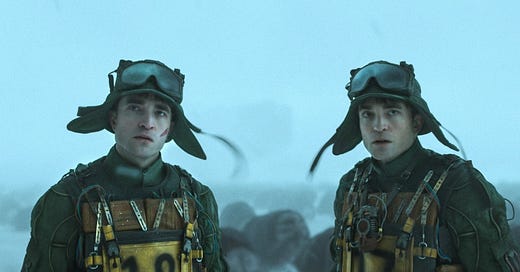We’ve endured so many terrible “eat the rich” satires in the aftermath of Parasite that it’s hard to remember a time when this sort of populist anticapitalist cinema could actually work. Bong Joon Ho’s films in this vein separate themselves from the rest of the putrid pack (seriously, this is probably one of my least favorite genres) in their genuine investment in narrative and their sense of careening motion. Swinging wildly in tone and genre, Bong’s films are works of refined craftsmanship and nostalgic sincerity, miraculously sidestepping the sneering obviousness of the genre’s worst practitioners.
Mickey 17, Bong’s Best Picture cash-in, upscales his preferred mode of anticapitalist sci-fi. With its interstellar setting and intricate creature work, this is Bong’s most extravagant spectacle thus far, even if it’s also one of his sloppiest. Adapted from Ashton Edward’s Mickey7, the film is set on the distant planet of Niflheim, where a group of humans, all attempting to escape catastrophe back on Earth, are forming a colony on the planet’s punishing snowscape. As Mickey, Robert Pattinson is the community’s “Expendable”, a subject in a 3-D printing study which allows participants to be cloned after death. He’s the bottom of the social hierarchy, and ruthlessly abused in scientific study, dying 16 times via nerve gas, vaccine trials, and radiation studies, only to be re-printed hours later.
Initially, Mickey 17 benefits from an off-kilter shapelessness. Trusting that the real-world resonances of the premise are cartoonishly obvious (gig-economy meets AI anxieties), Bong bounces from one plot to another, each more absurd than the last, and each containing another furious brushstroke of thematic relevance. This level of delirious anarchy is an interesting shift for Bong, whose films generally work within predefined narrative trajectories and clear spatial organizations. Perhaps it’s a sign of the times that after Snowpiercer’s lateral revolution and Parasite’s vertical fury, the only way to up the ante is by crafting a feature that’s perpetually bursting at the seams. Through Mickey’s discursive voice-over, which retraces the events that led to the co-existence of two Mickeys (17 and 18), we learn about the murderous loan shark whose bounty brought him into space, the psychopathic inventors of the human printer, his promiscuous romance with space officer Nasha (Naomi Ackie) and the history of the ship’s Trumpian Commander Marshall (Mark Ruffalo). Mickey is tons of fun when it refuses to be any one thing, springing between premises every few minutes in a fervent, “all you can do is laugh” tantrum. It occupies middle-ground between pop world-building and a broad-strokes exorcism of the current moment.
Unfortunately Mickey 17 can’t sustain its pitched frenzy, and thuds to a halt when it eventually settles into a plot. Marshall’s race war/vanity project against Niflheim’s roly-poly-like “creepers” is grating, a hasty Starship Troopers photocopy, but also criminally operates as if the preceding hour and change meaningfully engages with both character and theme. The tragic maximalism of the Mickeys’ climactic decisions is disorienting because the film actively avoids exploring the triangle between Nasha, Mickey 17, and Mickey 18 (it disappointingly flirts with the possibilities of fucking two Robert Pattinsons for a total of maybe 3 minutes), and the valedictory final sequence makes it seem like the entire film was building towards something entirely incidental. Whether due to studio interference, or just the realities of adapting an existing work of fiction, Mickey 17 feels cobbled together and retrospectively weightless, even if it contains flashes of a breakthrough.
Mickey 17 is distributed by Neon and is in theaters now.




